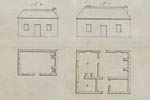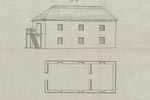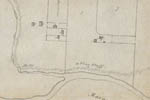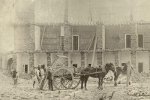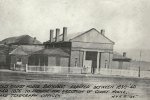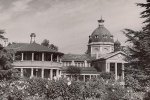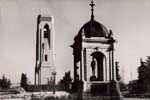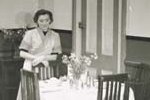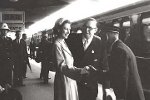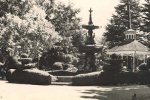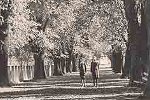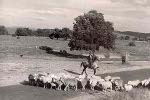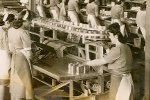
Bathurst, located approximately 200 km west of Sydney on the edge of the Great Dividing Range, was Australia’s first inland settlement. The site of the depot where Governor Macquarie stayed on his 1815 trip over the Blue Mountains is located in present-day Kelso, and it is from here that he proclaimed the town and named it after the British Secretary of State for the Colonies, Lord Bathurst.
Beginnings of a Settlement at Bathurst

View a larger version of the sketch
It wasn’t until February 1818 that Macquarie granted 50 acres of farmland to ten men: James and John Blackman, George Cheshire, William Lee, Richard Mills, John Abbott, John Neville, Thomas Kite, Thomas Swanbrooke and John Godden – NRS 897 [9/2652 p.42 Fiche 3266]. These first land grants were all on the eastern bank of the Macquarie River and the western bank was reserved for Government use only (such as soldiers, convicts and stock). This arrangement continued until 1826.
By 1822 the population of Bathurst at the General Muster in September included:
- 17 free men (11 born in Colony)
- 14 free women (seven born in Colony)
- 284 convicts (only one of which was a woman), and
- 33 children, of which 15 were boys and 18 were girls
(NRS 1286, Blue Books 1823, [4/251])
Bathurst was under the control of a Commandant and remained a small and isolated settlement for many years. It was, however, used regularly as a launching pad for a number of explorers such as George Evans (1815), John Oxley (1816-17), Allan Cunningham (1823) and Charles Sturt (1828).
1817
On the 24th March I received the Instructions of His Excellency
The Governor to take Charge of the Expedition, which had been fitted out for
the purpose of ascertaining the course of the Lachlan River and generally
to prosecute the Western interior of New South Wales.
On the 6th April I quitted Sydney, and after a pleasant Journey
arrived at Bathurst on the 14th, and found that the Provisions and other
necessary Stores, were in readiness at the Depot on the Lachlan River;
we were detained at Bathurst by rainy unfavourable Weather, until the
19th, when the morning proving fine, the Bat Horses, with the remainder
of the Provisions, Baggage and Instruments, were sent off, intending
to follow them the ensuing morning.
Bathurst had assumed a very different appearance since
I first visited it, in the Suite of His Excellency the Governor in 1815.
The Industrious hand of Man had been busy in improving the beautiful
works
(p.2)
Works of Nature; a good substantial House for the Superintendent had
been erected, the Government Grounds fenced in, and the Stock-Yards
shewed the abundant produce of the harvest, had amply repaid the
Labour bestowed upon the Culture. The fine healthy appearance
of the Flocks and Herds, was a convincing Proof how admirably
adapted these extensive Downs and thinly wooded Hills, are for their
grazing more particularly of Sheep. The mind dwelt with pleasure
on the Idea that at no distant period, these selected Plains would
be covered with Flocks, bearing the richest fleeces, and contribute in
no small degree to the Prosperity of the Eastern Settlements.
The Soil in the Immediate Neighbourhood of Bathurst, is for
the first Six Inches, of a light black vegetable mould, laying on a
Stratum of Sandy Soil of about 18 Inches deep, but of a poorer description,
and mixed with small stones under which is a strong clay.
The Surface of the Hills is covered with small gravel, the
Soil light and sandy with a subsoil of Clay, the low flats on the
immediate border of the River, are evidently formed by Washings
from the Hills and Vallies deposited by Floods and the overflowings
of the Water Courses.
April 20th Proceeded on our Journey towards the Lachlan River
John Oxley, on his second visit to Bathurst in 1817 commented on the development of the town and the potential for future growth based around farming and agriculture.
New developments
1825
Convicts
There are twelve pages of instructions to the new Commandant of Bathurst, John Fennell, that provide a tantalising glimpse into the life of the inhabitants of early Bathurst. Convict life was heavily regulated, from the huts they lived in, what they wore and when they worked and ate.
Convicts were given a yearly allowance for:
- two shirts
- two frocks
- two pairs of shoes
- two pairs of trousers and
- a straw hat (from NRS 897, 4/3514, p.165).
Their other belongings were limited to a blanket, knife, fork, spoon, plate, jug and a bowl NRS 897 [4/3514, p.166].
Convicts were to work on agricultural activities such as cultivating wheat, oats, flax and vegetables [4/3514, p.171]. The Commandant was also under strict instructions on how to run the Convict Establishment, with several pages devoted to the required recordkeeping of a day book, letterbook, personal journal and receipt books. One of the final instructions to Fennell is “never to be absent from your Command. You are faithfully and honestly to discharge the duty of Commandant.” NRS 897 [4/3514, p.174].
See below for the first two pages of the letter to John Fennell, Commandant of Bathurst from Governor Thomas Brisbane, NRS 897 [4/3514 pp.163-4, Reel 6014] or view a larger version here.

Government House, Sydney
13th April 1825
Sir,
Having appointed you in
succession to Major Morisset, Commandant
of Bathurst, I transmit to you the following
instructions for your guidance.
A new Site for the settlement
of Bathurst having been chosen by the late
Commandant, your future residence is to
be placed so as to command a view
of every part. The rows of Convict huts ought
to converge to it as a f ours, and Overseers
houses should be placed at the outer
extremity of each Row. These huts
are to be built of bush, the
windows of wood, should be made to
swing on hinges like the Parts of a
Man of War. The huts are to be
ranged in straight lines at the distance
from each other of three yards. The Streets
p.164
Streets are to be fifty feet wide, out of which
ten on each side is to be occupied by an elevated
foot path. Every hut is to lodge three Convicts.
Each married couple are to have one for themselves
and they are to be built detached from the rest.
Upon every Sunday morning at Six
O’clock the Convicts are to be mustered by the
Overseer of their respective Gangs when they are
to be taken to bathe. Two hours will then be
allowed for making an Exchange of Clothes at
the ? store and for cleaning themselves. At
tea they are to be mustered in the presence
of the Commandant, who is to enquire into any
discrepancy of dress, and to see that they are
perfectly clean. Divine service will then be
first read by one of the Civil Officers in the
absence of a Chaplain.
Every morning except Sunday
the Convicts are to be mustered in their
respective Gangs by
their Overseer at day
light, and the names of those who may be
missing are to be reported immediately to
yourself. The hours of labour will be
from daylight to eight, one hour and a
half will then be allowed for breakfast,
previously to which they are to be obliged
to wash themselves. From half past
nine until twelve work will be resumed,
one hour will then be allotted for dinner,
and labour will continue afterwards from
one o’clock till Sunset.
Building Plans
This plan accompanies a letter from John Maxwell, Superintendent of Crown Stock at Bathurst to the Governor requesting permission to build his long awaited house on No. 2 Kings Run outside of Bathurst.

1830s
Several events opened Bathurst and the West for more expansion in the 1830s.
Victoria Pass
The first of these developments was the discovery of Victoria Pass in 1832 by the Surveyor General Thomas Mitchell. This allowed for improved and quicker travel across the Mountains. By 1835 a regular coach service between Sydney and Bathurst had been established.
Town allotments
Another development was the decision to open up the Government Reserve at Bathurst for sale to the public in 1833 by Governor Bourke. Mitchell was charged with drawing up plans for a new town of Bathurst and the location was changed to its present-day site. The town was then surveyed and laid out by Assistant Surveyor JB Richards on 12 September 1833. The sale of the first town allotments occurred in the previous month with sales to JH Barsden, John Blackman and the Presbyterian Church (Greaves p.19).

View a larger version of the plan
Churches
Improved access through the Mountains and the corresponding population growth was followed by a number of churches establishing themselves at Bathurst. In 1825 Rev John Espy Keane became the first Anglican minister to be stationed at Bathurst and by 1834 the Holy Trinity Church at Kelso had been built, thereby becoming the first church building west of the Mountains. The first Catholic Mass was celebrated in November 1830 by Fr John Joseph Therry and work began on St Michael’s Church in 1839.
By 1834 the population of Bathurst had increased to:
- 873 free men and 251 free women
- 1880 convict men and 119 convict women
- 176 boys and 153 girls.
(NRS 1286, Blue Books 1834 [4/265]).
Boom times in the 1850s
The discovery of payable gold at Ophir in 1851 brought about a boom time for Bathurst. Although gold had been discovered in the region as far back as 1823 it wasn’t brought to the public’s attention until 12 February 1851 when Edward Hargreaves announced his discovery of payable gold.
Bathurst became the commercial hub for the thousands of gold miners on their way to the diggings in the surrounding area. The population rapidly grew and the town expanded, becoming a municipality in 1852. Cobb & Co moved their headquarters from Victoria to Bathurst in 1862 (see Wikipedia). More hotels and inns flourished, postal and gold coach runs were established, coal mining started and in 1876 the Main Western Railway line reached Bathurst, providing another important industry for the town.
Agriculture
For many years farming and agriculture had been the mainstay for Bathurst and the surrounding area. Sheep farming for wool, in particular, was a success on the Bathurst Plains but cattle and horses were also farmed. Agriculture, such as fruit and vegetable production and orchards developed from the 1900s onwards and several canneries were established to utilise the freshly grown produce.
Teaching Farm
Bathurst Experiment Farm (Agency 1976 in Archives Investigator) opened its doors in 1895 with the aim of educating student and local farmers. By 1913 there was accommodation for 34 resident students undertaking the two-year study course with several permanent staff members.
During World War II the Teaching Farm was suspended and the site used as an Ordnance Depot. The Farm location eventually became the site for the Bathurst Teachers College in 1951. Education and tourism remain important economic contributors for Bathurst.
Population
The population for the town had also grown over these years.
| Census | 1861 Census* | 1871 Census* | 1881 Census* | 1891 Census^ |
|---|---|---|---|---|
| Total pop | 4042 | 5030 | 7221 | 9162 |
| Male | 2127 | 2611 | 3657 | 4591 |
| Female | 1915 | 2419 | 3564 | 4571 |
*NRS 687 [6/5602pt], Census of 1881, Table 14, p.xix
^NRS 688 [6/5604], Results of a Census of NSW, 1891, p.7
Related photos
Browse more images of Bathurst in Photo Investigator
Research by
Suzanne Upton, Archivist Public Access
